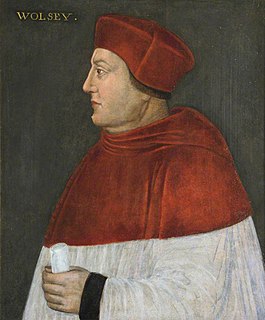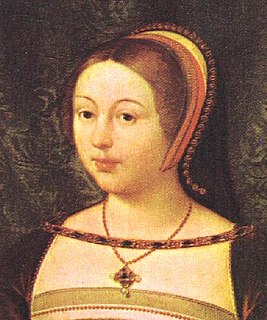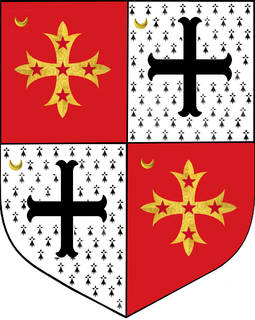Related Research Articles

Catherine of Aragon was Queen of England from June 1509 until May 1533 as the first wife of King Henry VIII; she was previously Princess of Wales as the wife of Henry's elder brother, Arthur.

Thomas Wolsey was an English statesman and Catholic bishop. When Henry VIII became King of England in 1509, Wolsey became the king's almoner. Wolsey's affairs prospered, and by 1514 he had become the controlling figure in virtually all matters of state. He also held important ecclesiastical appointments. These included the Archbishopric of York—the second most important role in the English church—and that of papal legate. His appointment as a cardinal by Pope Leo X in 1515 gave him precedence over all other English clergy.

James V was King of Scotland from 9 September 1513 until his death in 1542, which followed the Scottish defeat at the Battle of Solway Moss. His only surviving legitimate child, Mary, Queen of Scots, succeeded him when she was just six days old.

Mary Tudor was an English princess who was briefly queen of France. She was the younger surviving daughter of King Henry VII of England and Elizabeth of York, and the third wife of Louis XII of France, who was more than 30 years older than her. Following his death, she married Charles Brandon, 1st Duke of Suffolk. Performed secretly in France, the marriage occurred without the consent of Mary's brother, Henry VIII. The marriage necessitated the intervention of Thomas Wolsey; Henry eventually pardoned the couple, after they paid a large fine.

Margaret Tudor was Queen consort of Scotland from 1503 until 1513 by marriage to James IV of Scotland and then, after her husband died fighting the English, she became regent for their son James V of Scotland from 1513 until 1515.

Margaret Douglas, Countess of Lennox, was the daughter of the Scottish queen dowager Margaret Tudor and her second husband Archibald Douglas, 6th Earl of Angus. In her youth she was high in the favour of her uncle, Henry VIII of England, but twice incurred the King's anger, first for her unauthorised engagement to Lord Thomas Howard, who died in the Tower of London in 1537 because of his misalliance with her, and again in 1540 for an affair with Thomas Howard's nephew Sir Charles Howard, the brother of Henry's wife Catherine Howard. On 6 July 1544, she married Matthew Stewart, 4th Earl of Lennox, one of Scotland's leading noblemen. Her son Henry Stuart, Lord Darnley, married Mary, Queen of Scots, and was the father of James VI and I.
Arthur Plantagenet, 1st Viscount Lisle, KG was an illegitimate son of the English king Edward IV, half-brother-in-law of Henry VII, and an uncle of Henry VIII, at whose court he was a prominent figure and by whom he was appointed Lord Deputy of Calais (1533–40). The survival of a large collection of his correspondence in the Lisle Letters makes his life one of the best documented of his era.
Thomas Ruthall was an English churchman, administrator and diplomat. He was a leading councillor of Henry VIII of England.

The Tudor architectural style is the final development of Medieval architecture in England and Wales, during the Tudor period (1485–1603) and even beyond, and also the tentative introduction of Renaissance architecture to Britain. It followed the Late Gothic Perpendicular style and, gradually, it evolved into an aesthetic more consistent with trends already in motion on the continent, evidenced by other nations already having the Northern Renaissance underway Italy, and especially France already well into its revolution in art, architecture, and thought. A subtype of Tudor architecture includes Elizabethan architecture from about 1560 to 1600 which has continuity with the subsequent Jacobean architecture in the early Stuart period.
Berwick Pursuivant of Arms in Ordinary was an English office of arms created around 1460 for service on the Scottish Marches based at Berwick-upon-Tweed. In the 16th century there was also a Herald or Pursuivant based at Carlisle on the west border.
Sir William Compton was a soldier and one of the most prominent courtiers during the reign of Henry VIII of England.
Thomas Magnus (1463/4–1550) was an English churchman, administrator and diplomat.

The Scottish royal tapestry collection was a group of tapestry hangings assembled to decorate the palaces of sixteenth-century kings and queens of Scotland.

Brussels tapestry workshops produced tapestry from at least the 15th century, but the city's early production in the Late Gothic International style was eclipsed by the more prominent tapestry-weaving workshops based in Arras and Tournai. In 1477 Brussels, capital of the duchy of Brabant, was inherited by the house of Habsburg; and in the same year Arras, the prominent center of tapestry-weaving in the Low Countries, was sacked and its tapestry manufacture never recovered, and Tournai and Brussels seem to have increased in importance.

Sir Anthony Ughtred or Oughtred, Knight banneret was as an English soldier and military administrator during the reigns of Henry VII and Henry VIII. Ughtred fought in Ireland, the Anglo Scottish border and both on land and at sea in France. He served with distinction as captain of Berwick, marshal of Tournai and governor of Jersey. In 1530, he married Elizabeth Seymour, sister to Jane, future third wife to Henry VIII.
Roger Corbet (c.1501–1538) was an English politician and landowner of the Tudor Period. A member of the Shropshire landed gentry, he represented the Borough of Truro in the English Reformation Parliament.
Jerome or Girolamo Frescobaldi was an Italian financier and textile merchant in Bruges and at the Scottish court.

Eleanor or Alianor Verney was an English courtier who travelled to Scotland with Margaret Tudor in 1503.

Cornelis Hayes or Heys was a Flemish jeweller who settled in London in 1524.

Several documents list the jewels of Margaret Tudor, daughter of Henry VII of England and Elizabeth of York. Margaret married James IV of Scotland in 1503.
References
- ↑ Eleri Lynn, Tudor Textiles (London, 2020), p. 110.
- ↑ Joseph Bain, Calendar of Documents relating to Scotland: 1357–1509, vol. 4 (Edinburgh, 1888), p. 441
- ↑ Thomas P. Campbell, Henry VIII and the Art of Majesty (Yale, 2007), pp. 91–92, citing a corresponding account, PRO TNA E101/415/7, fol. 98.
- ↑ Maria Hayward, Great Wardrobe Accounts of Henry VII and Henry VIII (London, 2012), pp. 155-8.
- ↑ J. S. Brewer, Letters and Papers, Foreign and Domestic, Henry VIII, 1509-1514, vol. 1 (London, 1920), no. 3272: Letters and Papers, 2:2, p. 1524.
- ↑ Frances Lennard & Maria Hayward, Tapestry Conservation: Principles and Practice (Abingdon, 2006), p. 16.
- ↑ Letters and Papers, 2:1 (London, 1864), p. 874 no. 2736.
- ↑ Gordon Kipling, 'Henry VII and the origin of Tudor patronage', Guy Fitch Lytle & Stephen Orgel, Patronage in the Renaissance (Princeton, 1981), p. 140.